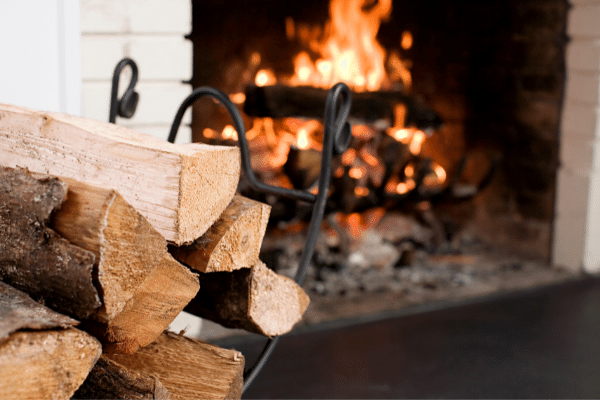- Home
- Storing Firewood
- Standard Firewood Length
Standard Firewood Length
This post may contain affiliate links so I earn a commission.
Understanding common firewood measurements, or standard firewood length is important.
Heating your home, cooking your food, or just sitting around a fire with friends and family requires an involved process of cutting and splitting wood.
While it's not too difficult to fell a tree and slice it up equally, there are a lot of benefits that come from knowing the length of which you should cut your firewood to.
The use of the firewood, the species of wood, and the efficiency you’re going for can all determine how long, or short you want your firewood to be.

The standard length for a piece of firewood is 16 inches.
However, depending on the size of your wood stove or fireplace, you could prefer larger logs that are 18-24 inches long.
You may even notice that you need to go shorter than the standard 16 inches, like when utilizing a miniature wood burning stove or chiminea that will only eat 8-inch logs.
Standard Firewood Length For Safety And Efficiency
Determining the proper firewood length all comes down to safety and efficiency.
Everyone is going for the highest level of efficiency possible.
You want to have wood that will burn hot for a long period of time.
While not all types of wood are going to provide this result, it can be manipulated a bit with proper firewood length.
For example, a longer length can provide heat over a broader area, making it either more or less efficient, depending on what you’re trying to do.
When cooking, you can heat multiple pans at once with a longer log, but if you’re only boiling water, shorter logs will channel that heat more efficiently.

Sometimes cutting everything longer can seem like a good idea, but it can actually burn unequally and make your heating less efficient if the log is too long.
This is especially noticeable in a fire pit when the center of the log burns through leaving small unburned chunks of wood on each end.
In these cases, you end up wasting wood rather than getting the most heat per log as possible.
However, when heating with a wood stove, I like my firewood to fill the firebox as much as possible.
You'll get a longer burn time this way, and it will cut down on how many times you'll have to refill the stove with wood.
Softwood vs Hardwood
One of the biggest factors to consider is the different type of wood you’re using.
Is it a softwood, or a hardwood?
Soft and hardwoods burn at very different rates, with different heat outputs as well, making them great choices for completely different tasks.
Hardwoods, such as oak and locust, burn slowly at a high temperature, which is why everyone loves using them for a wood stove in the winter.
However, when you cut these past the standard firewood length, they can burn unevenly inside of the stove if your fire is not hot enough, and not function as efficiently as possible.

Softwoods, like pine and spruce, burn quickly with a fast burst of heat.
These tend to be used more often when you want a tall flame for cooking, or for enjoyment sitting around a bright fire.
Shorter lengths of softwood are going to burn quickly, so when the chance is there, long lengths of softwood are the best choice to get the most efficient burn.
Hardwood is also more difficult to split than softwood, meaning longer lengths of wood will take a lot more energy to split if you’re doing it by hand.
This is important to take into consideration as you may be left without any energy if you’re splitting long lengths of wood all day long.
Softwoods split with a lot less spent energy, meaning you can split longer lengths for longer periods of time without getting tired.
Standard Firewood Length - Overall
The use of your wood is a major factor that needs to be looked at when deciding on standard firewood length.
If you’re cooking over a fire, the length of wood is going to be different than the length of wood for a wood stove.
The reason being, you’re aiming for two different results.
A wood stove often has limits on how long your firewood can be, and depending on the size of the firebox inside the stove.

If you’re cutting wood to burn in a fire pit, you’re free to cut longer lengths of wood when the fire won’t need to be maneuvered and handled as much.
You can toss a bunch of longer logs on the fire and then you’ll have less maintenance for longer time periods, leaving you with more time to relax.
This works well for outdoor fire pits, but not when you have the limited space of an indoor wood stove.
Cooking is a completely different game.
You may be tempted to use longer pieces of wood so you can maintain a consistent flame for an extended period of time, but it also makes the temperature a bit harder to control.
Shorter logs will condense that space and make it easier to manage, making shorter firewood lengths the best choice for cooking fires.
This can be a process of trial and error for a lot of people.
While there are standard firewood lengths for everything you’re doing, you can easily find that you prefer one length over the other, making it a very personal and custom process.


